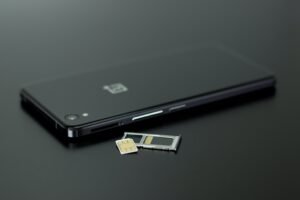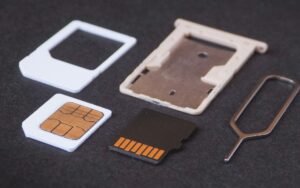Unlocking the Secrets of SIM Cards
In the dynamic world of mobile technology, the Subscriber Identity Module, commonly known as the SIM card, plays a crucial role in connecting users to their mobile networks. Over the years, SIM cards have undergone significant transformations, evolving in size and functionality to meet the demands of increasingly compact and powerful mobile devices. In this comprehensive guide, we’ll explore the various types of SIM cards, their dimensions, and the evolution of SIM card technology.
1. The Journey Begins: Full-Size SIM (1FF – 1st Form Factor)
The inception of SIM cards traces back to the era of larger mobile devices, where the Full-Size SIM, often referred to as the 1st Form Factor (1FF), made its debut. With dimensions reminiscent of a credit card (85.6 mm x 53.98 mm x 0.76 mm), this original SIM card size laid the foundation for the technology we rely on today. While not commonly found in modern smartphones, it still holds a historical significance as the precursor to the more compact SIM card variations.
2. The Regular Contender: Mini-SIM (2FF – 2nd Form Factor)
As mobile devices continued to evolve, the need for smaller and more efficient SIM cards became apparent. The Mini-SIM, or 2nd Form Factor (2FF), emerged as the standard for many years. Its dimensions (25 mm x 15 mm x 0.76 mm) struck a balance between the larger Full-Size SIM and the miniaturization trends in mobile technology. While it has become less prevalent with the advent of smaller SIM card sizes, the Mini-SIM remains a part of the evolutionary timeline of SIM card technology.
3. Shrinking Further: Micro-SIM (3FF – 3rd Form Factor)
The demand for even smaller SIM cards led to the introduction of the Micro-SIM, designated as the 3rd Form Factor (3FF). With dimensions of 15 mm x 12 mm x 0.76 mm, the Micro-SIM gained popularity with devices like the iPhone 4, which sought to optimize internal space. Although less common in recent smartphones, it remains in use in some older devices, showcasing the adaptability of SIM card technology to the ever-changing landscape of mobile devices.
4. The Pinnacle of Miniaturization: Nano-SIM (4FF – 4th Form Factor)
In the pursuit of creating slimmer and more lightweight smartphones, the Nano-SIM, or 4th Form Factor (4FF), emerged as the smallest standard SIM card size. With dimensions of 12.3 mm x 8.8 mm x 0.67 mm, the Nano-SIM became the de facto choice for modern smartphones. Its reduced size not only facilitated the creation of sleeker devices but also allowed manufacturers to allocate more space for other critical components within the device. The Nano-SIM is currently the most widely used SIM card size, representing the pinnacle of miniaturization in the SIM card evolution.
5. Beyond Physical Boundaries: eSIM (Embedded SIM)
The evolution of SIM card technology transcends physical dimensions with the advent of the Embedded SIM, commonly known as eSIM. Unlike its physical counterparts, the eSIM doesn’t have predefined dimensions as it is embedded directly into the device. This revolutionary technology allows for remote SIM provisioning and enables users to switch between carriers without the need to physically swap a SIM card. eSIMs are increasingly adopted in newer smartphones, smartwatches, and other Internet of Things (IoT) devices, heralding a new era of flexibility and convenience for mobile users.
Choosing the Right SIM Card: Considerations and Compatibility
Selecting the appropriate SIM card for your mobile phone involves considerations beyond just size. Compatibility with both the device and the mobile carrier is paramount. Before making a decision, it’s essential to check the specifications of your mobile phone and verify with your carrier to ensure that the chosen SIM card is supported.
Some smartphones may support multiple SIM card sizes through the use of adapters, providing users with flexibility when switching between devices. However, it’s crucial to exercise caution when using adapters, as improper handling can lead to damage to both the SIM card and the device’s SIM card slot.
Additionally, when choosing a SIM card, it’s essential to consider the network bands supported by both the device and the carrier. Different regions and carriers may use varying frequencies for their networks, and ensuring compatibility ensures a seamless and reliable mobile experience.
Conclusion: Navigating the SIM Card Landscape
In the ever-evolving landscape of mobile technology, the humble SIM card continues to play a vital role in connecting users to their mobile networks. From the credit card-sized Full-Size SIM to the miniature Nano-SIM and the boundary-breaking eSIM, the journey of SIM card evolution is a testament to the relentless pursuit of innovation in the tech industry.
As we embrace the era of compact and powerful smartphones, the choice of SIM card has become more nuanced than ever before. Whether it’s the physicality of the traditional SIM cards or the virtual versatility of eSIMs, users now have a range of options to suit their preferences and needs.
Ultimately, understanding the types and evolution of SIM cards empowers users to make informed choices when it comes to connectivity. Whether you’re upgrading your device, switching carriers, or exploring the possibilities of eSIM technology, the world of SIM cards invites you to navigate its intricacies and stay connected in the most convenient and efficient ways possible.








